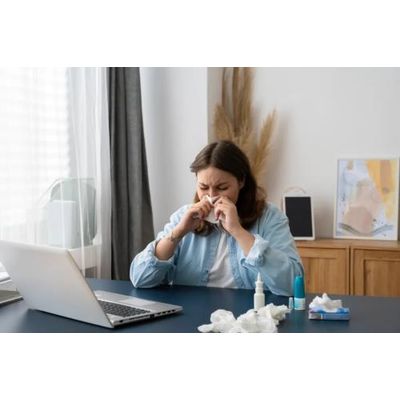


Dust Allergy Symptoms
Do you sneeze, cough, and have itchy eyes after cleaning your house or coming into contact with dust? Then, You could have a dust allergy, a common illness. When you think about allergies, you might think of pollen or pet dander. However, another prevalent cause that often goes undiscovered is dust allergies. Dust allergies are among the most pervasive indoor allergens today. While not life-threatening, Toxins and debris build up all over our homes, including hallway corners, beside TVs, around flowerpots, and in the air, causing dust. However, it can cause discomfort and affect your quality of life.
Dust allergy symptoms can be very irritating. To treat the infamous itchy nose and uncomfortable sinus pressure associated with dust allergies, it’s critical first to understand what triggers these symptoms. To assist you in better managing this irritating illness, we will look at the symptoms, importance of recognizing, and treatment options for dust allergies in this blog post. So read on to learn everything there is to know about dust allergies! Moreover, it will help you better understand this often-overlooked issue.
Around 84 percent of USA households have been detected with house dust mites. In industrialized areas, like Germany, 1 out of every four people is affected by dust mite allergy. Combined, allergic rhinitis (AR) and asthma affect up to 800 million people worldwide, according to the World Health Organization (WHO).
Recognizing and controlling its symptoms is critical for immediate relief and long-term health and well-being.
Dust mites are the primary cause of dust allergies. These microscopic organisms feed on the dead skin cells of humans and animals. They are widespread in bedding, pillows, mattresses, and upholstered furniture. When you inhale or consume dust mite particles, your immune system attacks. Histamine is a substance secreted by cells in response to threats or offenders. Histamine release causes common allergic symptoms such as itchy eyes, watery eyes, and a runny nose.
Though just one of many allergens, dust mites have a far-reaching influence, affecting about 20 million Americans.
The first step in dealing with dust allergies is raising awareness. It is critical to identify your triggers. Dust mites, pollen, mold, and animal dander are common causes. Take note of when and where symptoms increase. Is it during the cleaning process or pollen season? Knowing your triggers allows you to tailor your management strategy.
While it is hard to eliminate dust mites, there are effective dust allergy management strategies:
- Clean and dust your home regularly with moist towels to reduce airborne pollutants. To catch microscopic allergens, vacuum with a HEPA filter.
- Bedding Care: To destroy dust mites, wash bedding, pillowcases, and curtains in hot water regularly. Consider using allergen-proof material to cover your pillows and mattress.
- Reduce Humidity: Use a dehumidifier to keep indoor humidity levels below 50%, inhibiting dust mite growth.
- High-quality air purifiers with HEPA filters can assist in removing allergens from the air.
- Declutter: Reduce the number of items that collect dust, such as soft animals and unnecessary things.
Dust allergies can manifest with a range of symptoms. Dust allergy symptoms are remarkably similar to other types of allergies, such as hay fever or animal allergies. The following are the most prevalent symptoms:
The most typical signs of a dust allergy are respiratory problems. This includes
- Sneezing: People with this illness may sneeze frequently during the day, particularly in dusty conditions or when exposed to other triggers.
- Runny or stuffy nose: This can make it difficult for those with dust allergies to breathe appropriately and, if not addressed promptly, can progress to other difficulties such as sinus infections.
- Coughing: A frequent symptom caused by mucus buildup in the throat.
Itchy, Watery Eyes: Irritation and itchiness in the eyes, along with excessive tearing. Rubbing the eyes can exacerbate the irritation and should be avoided.
Many persons who are allergic to dust experience itchy skin or a rash. It is a more severe symptom that may indicate anaphylaxis. Hives are another symptom of dust allergies and can indicate anaphylaxis. Therefore, they should be treated every single time.
Dust allergies can also cause additional symptoms that affect general health. Fatigue: Allergic responses can cause fatigue and an overall sense of ill-health. Headaches and facial pressure, particularly around the sinuses, can occur due to nasal congestion. It’s important to note that symptoms can vary in intensity and combination from person to person.
Dust allergy symptoms can vary from low to moderate to severe, depending on the individual. The severity of dust allergy symptoms varies significantly from person to person. It is impacted by many factors, such as the individual’s immune system response, dust mite exposure, and other respiratory disorders. Dust mite allergens, for example, can be severe for those with asthma, especially after long-term exposure.
According to the Institute for Quality and Efficiency in Healthcare, dust mite allergies generally start in childhood and persist into adulthood. Later in age, the allergic reaction might spread to the lungs and cause asthma.
- immune System Response: Every man or woman’s immune system reacts differently to allergens. Some individuals can also have a heightened sensitivity, leading to extra severe reactions whilst exposed to dust mites. In evaluation, others may experience slight symptoms or none in any respect beneath similar conditions.
- Level of Allergen Exposure: The amount and frequency of exposure to dust mites can impact symptom severity. People living in environments with high concentrations of dust mites or frequently exposed to dirt (like in certain occupations) might also go through extra intense signs.
- Genetic Factors: Genetics can play a role in determining the severity of allergic reactions. A family history of allergies or asthma might predispose an individual to more severe allergic responses.
- Age and Lifestyle Factors: Age can influence the severity of allergic reaction signs and symptoms, with a few individuals locating that their signs and symptoms alternate over the years. Lifestyle elements, including smoking or dwelling in a polluted vicinity, can also exacerbate symptoms.
You must get medical attention if your symptoms are persistent, severe, or impacting your quality of life. An allergist can do tests to determine whether you have a dust allergy and offer treatment choices such as antihistamines, decongestants, or allergy shots (immunotherapy).
- The allergist will ask comprehensive questions about your work and home surroundings, family medical history, frequency and severity of symptoms, and exposure to pets and other potential triggers to locate the source of your problems.
- Sometimes, a medical interview will uncover a possible culprit—for example, a girl who gets a stuffy nose every time she plays with a friend’s cat may have an allergy to cats or the dust in her friend’s house packed with cat hair.
Dust allergy can be a frustrating and unpleasant illness to have to deal with you can, however, take steps to manage your symptoms and decrease your exposure to allergens. Dust allergies may not be as well-known as pollen or pet allergies, but they can be just as irritating for individuals who suffer from them. Taking simple precautions, such as removing shoes before entering the house and regularly cleaning floors and surfaces, can significantly reduce your risk of developing a dust allergy. By being aware of the causes and symptoms of dust allergies, you can control indoor and outdoor environments and reduce allergen exposure. You may minimize the impact of dust by using a robust Oizom dust monitoring system that provides real-time accurate data. Enjoy a healthier, more pleasant living area using excellent cleaning techniques and suitable remedies for dust.
